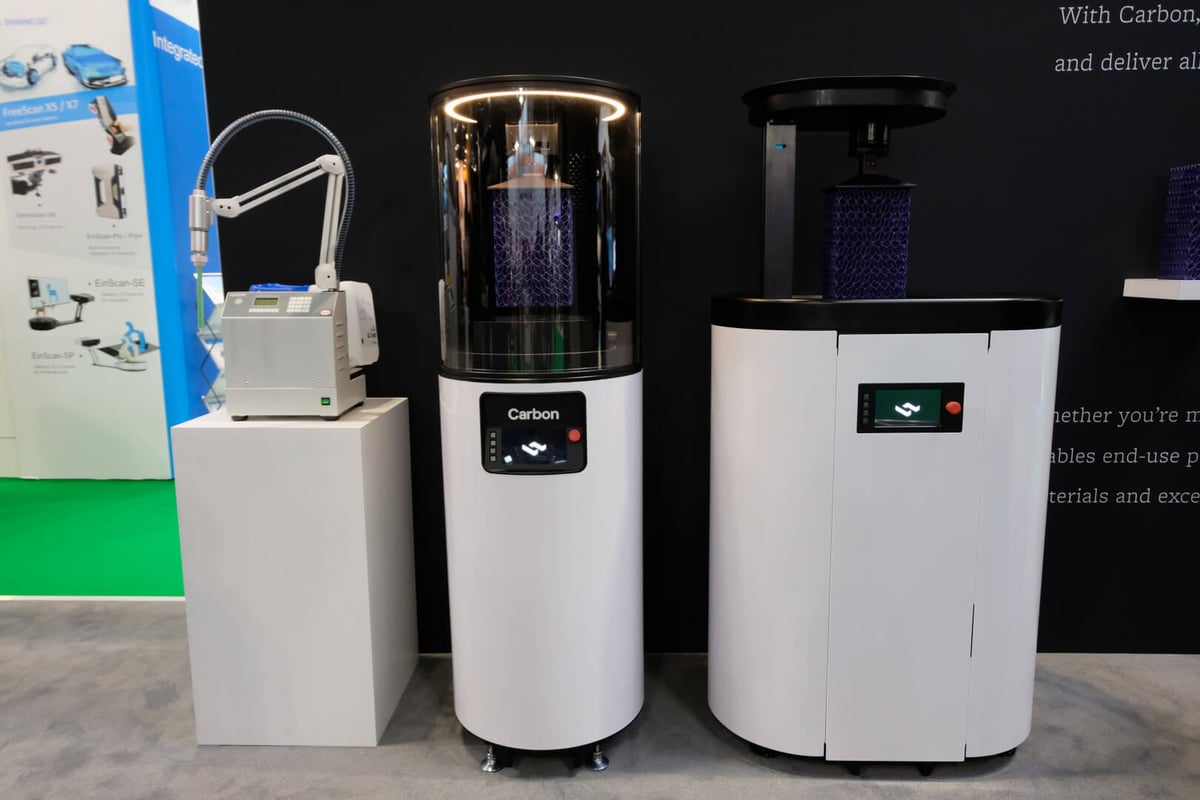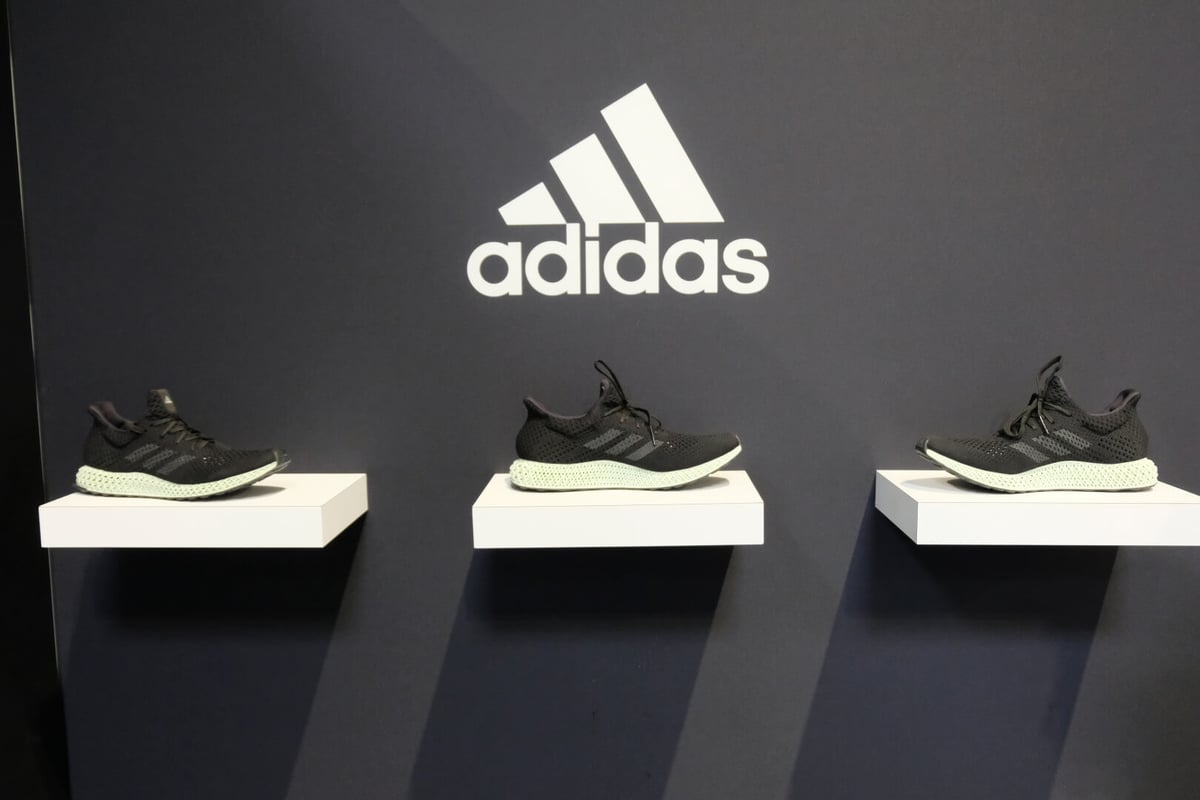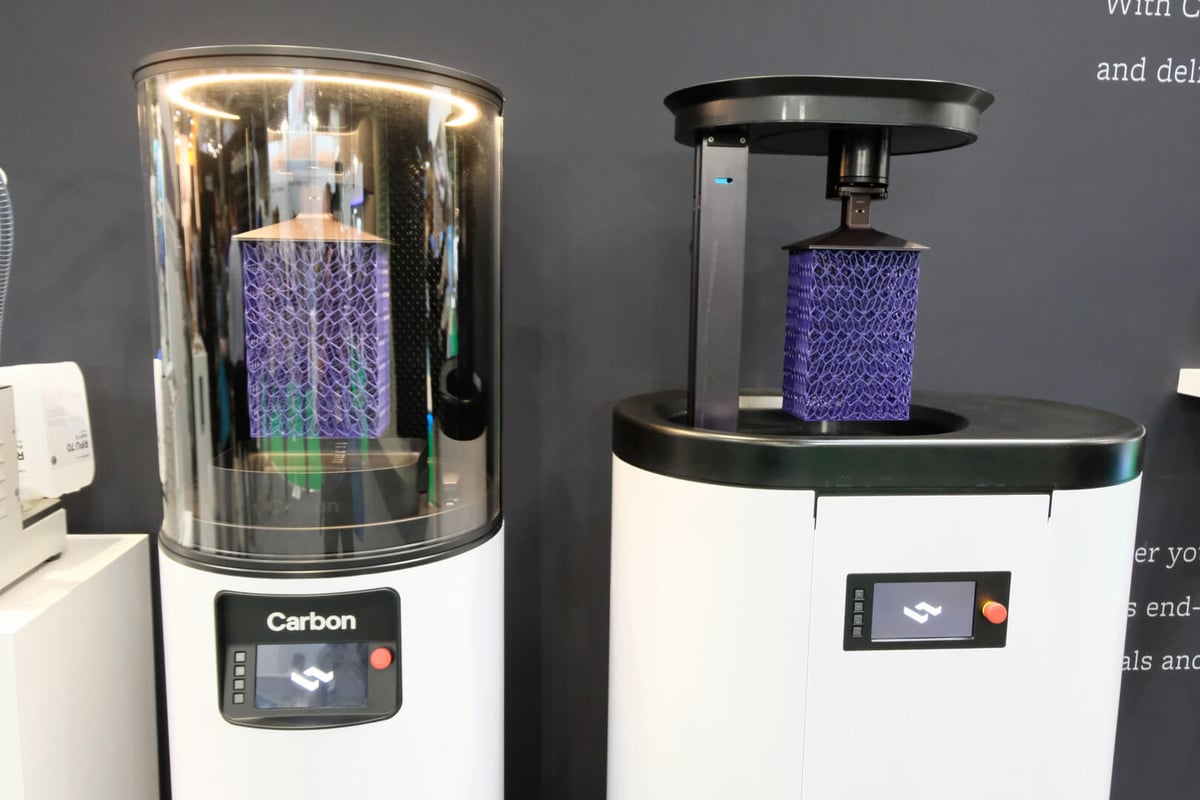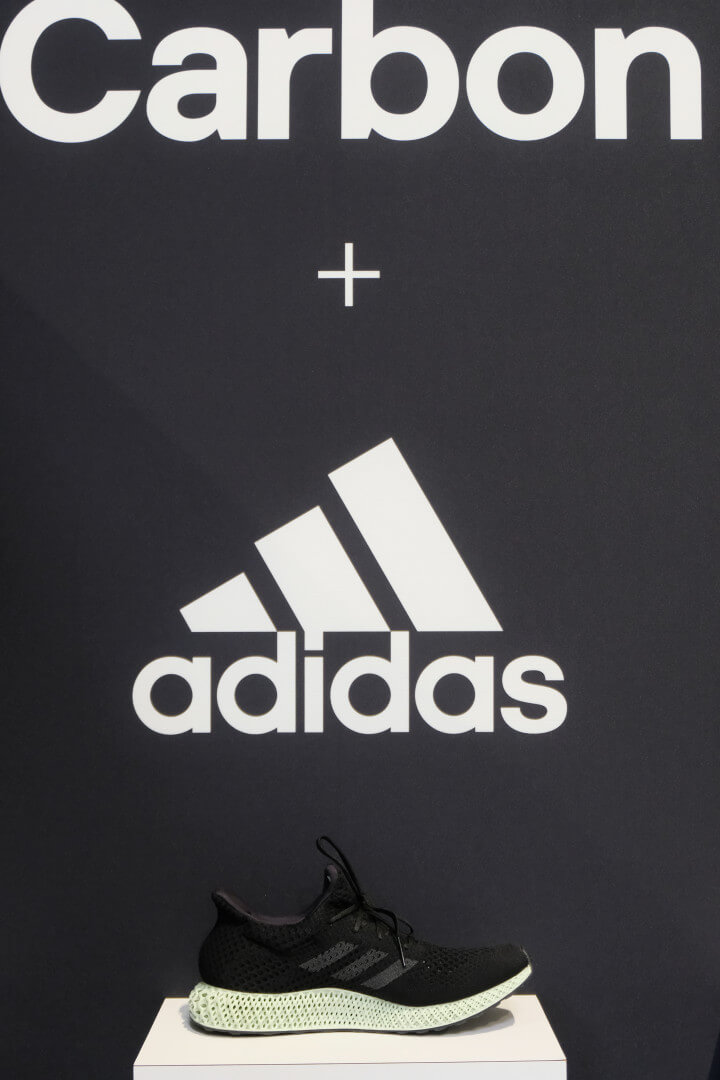Carbon’s Luke Kelly and Phil DeSimone talk Adidas Futurecraft, material innovation, and bringing 3D printing to the mass production stage.
While 3D printing has long been celebrated as a viable tool for rapid prototyping, the technology has generally struggled in meeting the demands of mass production. But starting in 2014, the Silicon Valley startup Carbon set out to dismantle these limitations with their CLIP (Continuous Liquid Interface Production) technology.
Shortly thereafter, the company released the M1 3D printer, the first machine to utilize this ultrafast and highly impressive technology. The CLIP process has been said to be 25-100 times faster than other photopolymer processes, and is also compatible with a wide range of production grade materials, from thermoplastics to elastomers.
Since then, Carbon has continued to develop new hardware and more innovative materials, while also stealing the spotlight this year with the announcement of their partnership with Adidas. The athletic apparel company is using the technology to mass produce the insoles for their Futurecraft 4D performance footwear, marking the first time 3D printing is truly being used for the purpose of serial production. Adidas is utilizing Carbon’s Digital Light Synthesis, which entails the use of digital light projection, oxygen permeable optics, and specially formulated liquid resin.
More recently, Carbon also revealed their new materials program, offering larger volumes of resin to help reduce the cost for their customers.
At TCT Show in Birmingham, Carbon had the remarkable Futurecraft sneakers on display, as well as their M2 and SpeedCell system. All3DP got to sit down with Luke Kelly, VP of Finance, and Phil DeSimone, VP of Business Development, to discuss the Adidas collaboration, their incredibly innovative materials and hardware, the task of taking on injection molding, and more.

What are some of the latest developments coming out of Carbon?
Luke Kelly: There are a lot. One of the biggest things we’ve announced here at TCT is our production resin program. As you know, additive has largely existed in the prototyping world. Obviously, there are a few fairly high-profile examples for production, but they’ve been fairly niche applications. Obviously, on the metal side it’s been with GE, and on the polymer side it’s been models for dental, whether it’s for thermoforming or other applications.
Following the Adidas announcement, we’re firmly targeting production and mainstream production in competing with what has traditionally been the domain of injection molding. Really, to do that well, we needed to innovate on the hardware and also reduce labor costs. The last piece is getting to production, resin delivery, and pricing. At AMUG, we announced the SpeedCell, which included a larger M2 that’s also globally compliant, and so we’ve started to install the first ones here in Europe just in the last month, and we’re really ramping up our business internationally on the back of that.
We also launched the Part Washer and the Part Washer’s really aimed at two things. One is taking what’s traditionally been a pretty labor-intensive piece of the operation for post-processing and making it very, very simple. The other thing is our commitment to end-to-end digital workflow, so we’re able to – actually, under the Part Washer, they’re able to identify what the part is, design a custom washing cycle for that particular material and geometry, and get much more accurate parts—reproducible parts—time and time again in a production environment.
One thing we’ve always found interesting about Carbon is how closely you work with your customers to develop the material they need. Can you talk about the process of working directly with your clients and developing new materials?
Kelly: Yes, for sure. It’s always been a core part of what we’ve done, but I think we’ve actually done an even better job over the last six to nine months. Initially, we focused on a breadth of resins because we really wanted to demonstrate the power of the platform and the ability to switch easily between materials, but now we’re going much deeper and driving towards broadly validated materials that can go into all kinds of end-use industrial applications. Before we kick off a material development process, we select a couple of customer sponsors who will help to set the specification for those materials.
As we look at our roadmap, that’s really now become a starting-off point for any new material development program, or even any new iteration of a material. So, our next generation epoxy will be very, very heavily informed by the requirements from people like Delphi, who has been one of our longest customers, as well as some of the end-use automotive companies and many into other industrials.

Obviously, your work with Adidas on the Futurecraft footwear has been one of the biggest industry announcements of the year. How did you sell this sportswear giant on the idea of working with Carbon to mass produce their insoles?
Kelly: In the case of Adidas, they had launched the Futurecraft 3D and were deep in the development process. I think that was actually really helpful because it showed the limitations of SLS and that it really wouldn’t be a technology that they could scale with. It also didn’t deliver the performance characteristics that were required; it didn’t have the energy return or the scalability. Actually, by the time we first started the dialog with Adidas, they were pretty well down along the path of, “Hey, we have to do this for the industry. This is the future of footwear, but we don’t have the solution.”
When we were able to combine our world-class materials with the fact that we can print mid-soles in 30 minutes or less versus people who’ve traditionally printed in 10 hours, that was a pretty powerful combination for us.
Phil DeSimone: There was no convincing needed. The question, for us, was actually finding the right partner. So, we spoke with all of the major athletic footwear players and really wanted to find someone that was in it for the long haul that wasn’t doing it just for a prop. Somebody that actually wanted to go and do something in tens of millions of pair a year.
What is interesting is if you actually look at what Adidas has done with Boost, it’s something that they took from nothing, from zero to 50 million pair in a span of three to four years. It was a material that no one knew for what to use it, how to use it, or when it should be used, and they took a bet that they could figure out how to process it. So, they had a tremendous amount of experience taking something very, very quickly and getting it into a mass scale, and that was something that, actually, to be transparent, some of the other folks who have been using the same materials for the last 20 years had never done.
“I actually think that 2017–2018 are the years that you’ll see that 3D manufacturing is actually here, and here now. People are all going to be going in that direction, and next year will really come down to how many additional parts we can find,” says DeSimone.
Are there some areas where you find it hard to compete with injection molding or traditional ways of manufacturing?
DeSimone: Yes. Consumer products is definitely one of those. Consumer products is making the same thing millions and millions and millions of times, and so it’s really, really difficult to compete against injection molding. We’re not here to replace injection molding. This is another tool in that toolbox, but we can do things that you can’t make any other way, and if you can do something that you can’t make any other way, that provides a performance advantage and value proposition, and then it doesn’t matter. You can’t compare to injection molding, but you can do things in millions of units a year.
I mean, Adidas is great, but our bread and butter is going to be the low- to medium-volume production applications where we can compete with injection molding and win right away on day one. Those are things in 10,000, 20,000, 30,000, or 100,000 units a year. That’s where we can really shine, and it’s going to be a major opportunity for us.
I think Adidas is exciting, and there will be a couple more that we have up our sleeve that are getting into millions of units a year, but they’re definitely more rare because it’s sort of that perfect combination of design, materials, and process in order to make something like that work, as well as a mission from the customer.

Can you go into a little more detail about the actual advantages that Carbon’s technology can offer over injection molding?
DeSimone: With very little effort, we can be more cost effective than injection molding in the sub-20,000 unit tier. Very straightforward. The cost of tooling is very expensive, and the lead times are a massive thing. Before you even have your tool made, I can have all of your 20,000 components to you. What people don’t talk about—and there’s actually a great piece on our website where we talk about injection molding, the true cost of injection molding.
That’s what no one really talks about. They talk about how you get the tool, and it takes four to six weeks for good people and somewhere between $10,000 and $50,000 depending on what type of material and how complex the part. Once you get that tool, you run a couple times, you look at the part, you make edits to that tool. Then, you’re out another four to six weeks. Those are the things that no one pays attention to, but they lead up to massive amounts of dollars.
I actually think that 2017–2018 are the years that you’ll see that 3D manufacturing is actually here, and here now. People are all going to be going in that direction, and next year will really come down to how many additional parts we can find.
It looks like you’re totally on a winning streak thus far. But what were some of the challenges you’ve experienced in the last year?
DeSimone: It’s always difficult. No one said manufacturing was easy, otherwise everyone would have done this. Right? The 3D printing has been at it for 30 years and still has really just scratched the surface on 3D manufacturing. We still have a journey ahead of us. This is not over. I think the most difficult thing is actually finding applications. Right now, it’s done through brute force, and it’s sort of a game of will. You need to have people who are willing to be along that journey for you.
Convincing them to tell the story of it is another one. The thing that we struggle with is that it’s hard to find more applications without telling people about other applications people have done. Those case studies are super important because people say, “I have that same problem.” Convincing those companies to do it is something that’s really tricky. They view it as a core competency or competitive advantage.
I think one of the things that I always push our customers to do when they find a production application is to tell a story, because what ends up happening is that if you keep that internally and your competitor releases two years from now, it doesn’t matter if you’ve been doing it for five years. You’re the laggard. That person looks like the ones that are pushing the industry, and we rely on that heavily.
What’s the most popular resin, currently?
DeSimone: Outside of the Adidas elastomer, RPU 70 is our most-used material. That’s the one that’s used by all of our automotive components. That’s the one that launched in the papers and the first one with the MMD. That’s dropping 40 percent per liter with the MMD, which is a big deal. A lot of our customers will be very happy. That’s what’s been used for the BMW components.
“I think one of the things that I always push our customers to do when they find a production application is to tell a story,” says DeSimone.
Can you talk about going from the M1 to M2, as well as the SpeedCell. What are the advancements you’ve made on the hardware end?
DeSimone: When we launched the SpeedCell, the whole thing was navigated towards production. There are three main cost drivers on a per-part basis: the hardware (the printers), the labor, and the material. The SpeedCell was really there to address the printer cost. You get efficiencies by having more than one. You sort of time them all and pull them all off in unison in order to get better per-part cost. The other thing is the Part Washer. The Part Washer massively reduced the labor cost. So then, when we look at what we did with the Henkel device, that is what allowed us the trust that through piece, which is a material piece.
When we released the SpeedCell, it was really addressed for manufacturers. When we talk about our production partners, those are the folks out there like Hertzler, who are doing the Adidas shoes, folks like Jabil and Flex, as well as small mom and pop shops in the Midwest. Paragon here in the UK just got a delivery of three machines, and those folks are doing serial production components.
The individual printer going from the M1 is really good at doing design validation. It’s the printer that we have in the majority of our OEMs. What they’re mainly doing is application discovery. Then they find the thing they want, they find the thing they like, and we pair them with a production partner that has the SpeedCells that can make it at scale. It’s really a nice ecosystem.

It’s really interesting to hear how the M1 is still being used, pushing it to the limit.
DeSimone: Oh, yeah. It’s still being used. That’s what’s great about the subscription, though. Those M1 users, at the end of their three-year period, they’re going to go to M2s. They always have the latest and greatest. It’s definitely a unique business model.
Outside of Adidas, are there any other use cases that have interested you that you can talk about?
DeSimone: There are so many uses… but we can’t talk about them. Look, we’re doing a lot of things in automotive. There will be a couple of really good stories before the end of this year in production, some with really awesome brands that have been around for a long time that I’m super excited about. Next year, there will be a ton. Again, at the end of the day, for us the most important piece is convincing people to tell that story.
Kelly: Other spaces we’re excited about is non-FDA medical, dental, or things that have a little shorter regulatory path. Again, it comes back to materials, so the fact that the cyanate industrial material we have has a very high heat deflection temperature but our materials are 100 percent dense, that it’s steam-sterilizeable—it’s pretty unique in this industry, and those are the perfect opportunities to apply this technology. We’re seeing a lot of really great traction in that space. That’s exciting from a business perspective and also because it drives better patient outcomes.
What’s your goal over the next year or so?
Kelly: Clearly, goal number one is to execute in scale with Adidas, for sure. I think we feel great about – well, I know we feel great about our partnership and the collaboration. It’s truly one team, and that’s been awesome, and that will continue. It’s also pulling us to stand up a global supply chain, which will have massive benefits in other areas of the business, too.
Then, I think it’s to continue to progress in manufacturing. As Phil said earlier and we’ve said many times, manufacturing is hard and takes a long time. I’ve built six factories in my life—very, very large ones, and even when you’re replicating a factory, it takes years of work in a large capital environment to fully validate, bring it up, and produce it. We’re very fortunate that we’re already engaged in those projects now, and we’re going through those validation cycles for the final production part.
So, expanding and growing what we’ve been able to do with Adidas but do it in all kinds of other verticals will be a really exciting part of our story in 2018.
“Following the Adidas announcement, we’re firmly targeting production and mainstream production in competing with what has traditionally been the domain of injection molding,” says Kelly.
Will we also see some new materials?
Kelly: Oh, yeah, absolutely. We’re really pushing the curve on materials and what’s possible. We will change the game. I know there will be a couple of amazing new materials early in 2018, and then more throughout the year.
DeSimone: There will be a new one in November, a whole new material family in November that will be super exciting for a lot of folks. Things that people have been wanting for a long, long time that no one’s really been able to figure out.
Yes, and in 2018 we’ll have a huge roadmap of all-new materials, new families, really focusing on fully validated production materials. Really, that’s the direction you need to go. When we say fully validated, we mean chemical resistant, thermally stable, passing flame ratings, all of those pieces, and this will be the first time anyone’s really done that in the world of SLA. RPU 70 is the first UL 94-rated SLA resin ever. We have ambitions to keep pushing that forward.
I also just want to gauge your personal views on – compared to when you guys started and where you are now – the additive manufacturing industry as a whole?
DeSimone: I don’t want to be controversial. I think there’s been a lot of great progress on the metal side. I think metal is frickin’ hard. Plastic is hard too, but metal’s a completely different ballgame. I think Desktop is doing some interesting things. Obviously, they’re share investors and friends with us. They’ve done some interesting things.
On the polymer side, to be honest with you, nothing else has changed. Not much, right? There’s no new materials. People are still using nylon 11 and nylon 12. You know, EOS has been using nylon 12 since 1995. If anyone’s done production with it since then, it’s not because of speed; it’s because of material properties. I’m proud to say that I think we’ve done a good job of continuing to push on the innovation front, never being satisfied. I think the rest of the plastics have been relatively the same since I started four years ago, and I was completely new to the industry. I knew nothing about it when I first started.
Kelly: I haven’t been around quite as long, but after a couple, two and a half years now in the industry, I think the thing that I’m most excited about is the momentum, and I think on the customer side, more and more people are truly thinking about production and moving to production. I think that’s evident not only by the actual parts and what we see, but also by investment, players moving into the space. Just about every large chemical company in the world is now fully dedicated to 3D. That’s a pretty massive change even over the last 12 months.

License: The text of "Carbon Talks Adidas Collaboration and Bringing 3D Printing to the Serial Production Stage" by All3DP is licensed under a Creative Commons Attribution 4.0 International License.